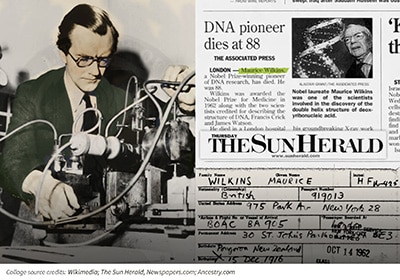Maurice Wilkins
Who Is Maurice Wilkins?
Maurice Wilkins was a famous scientist who shared a Nobel Prize with James Watson and Francis Crick in 1962 for their discovery of the double helix structure of DNA—a discovery which revolutionized the field of biology.
 Maurice Wilkins was born in 1916 to Irish parents living in New Zealand. When he was six the family moved to England. Wilkins received his PhD in Physics at the University of Birmingham before joining other leading researchers on the Manhattan Project in Berkeley, California during World War II.
Maurice Wilkins was born in 1916 to Irish parents living in New Zealand. When he was six the family moved to England. Wilkins received his PhD in Physics at the University of Birmingham before joining other leading researchers on the Manhattan Project in Berkeley, California during World War II.
After the war Maurice Wilkins returned to the U.K., where he conducted his most recognized work.
Maurice Wilkins and DNA
In 1946 Maurice Wilkins joined the Medical Research Council's Biophysics Unit under his mentor John Randall at King's College London. It was there that Wilkins began to study DNA's structure through X-ray diffraction, with the help of graduate student Raymond Gosling.
Four years later, in 1950, Wilkins discovered that he could produce very thin, uniform threads of DNA, using a sample of extraordinarily pure DNA he obtained from a Swiss scientist named Rudolf Signer. He and Gosling were then able to use the DNA fibers to take X-ray diffraction photographs that revealed the crystal-like structure of the DNA threads.
The following year, Wilkins' work took him to Naples, where he gave a talk on DNA. The American scientist James Watson was in the audience and became very excited about Wilkins' work on the structure of DNA. Not long afterward, Watson ended up at an academic institution not too far from King's College London, where Maurice Wilkins worked.
That same year, Wilkins' boss, John Randall, brought in another scientist to work on their team: a talented X-ray crystallographer by the name of Rosalind Franklin. In an interview years later, Wilkins attributed Franklin's recruitment to the fact that she was an expert in X-ray diffraction, whereas he was simply a general physical molecular biologist.
Both teams—Watson and Crick and Wilkins and Franklin—were at different labs. But in the fall of 1951, they came together when Watson and Crick presented their three-stranded helical model of DNA to Wilkins and Franklin.
Watson and Crick's 1951 attempt at describing DNA's structure, as Franklin quickly identified, was incorrect. But it provided yet another string in the series of interactions between Watson, Crick, and Wilkins that would eventually lead to their shared Nobel Prize.
Maurice Wilkins and the Nobel Prize
After Watson and Crick's failed three-stranded helical model of DNA, Lawrence Bragg, the head of the Cavendish Laboratory at Cambridge, instructed them to stop working on DNA. But they continued to discuss it on their own, keen on solving the mystery of the structure of DNA – a feat which would eventually earn them and Maurice Wilkins a Nobel Prize.
A breakthrough came in January of 1953, when Watson visited King's College and ran into Wilkins. Wilkins showed Watson an X-ray diffraction image of crystallized DNA captured by his colleague Franklin and the PhD student Raymond Gosling. The image of DNA, known as Photo 51, showed an X-shaped pattern which was consistent with a helical molecule.
Watson immediately recognized its significance later writing in his book, The Double Helix: A Personal Account of the Discovery of the Structure of DNA, 'The instant I saw the picture my mouth fell open and my pulse began to race.'
The combination of Franklin's images of DNA, along with her research which Watson and Crick obtained from Crick's thesis advisor Max Perutz, proved critical to helping Watson and Crick solve the mystery of DNA's double-helix structure.
On April 25, 1953, Watson and Crick published their findings in the journal Nature. In that same issue of the publication, two additional articles appeared: one by Maurice Wilkins and one by Rosalind Franklin and Raymond Gosling. In part because Watson and Crick's article was placed first, it appears as if their data merely supported Watson and Crick's research, rather than contributing to it.
The acknowledgment at the end of the article did little to clear this up, simply noting, 'We have also been stimulated by a knowledge of the general nature of the unpublished experimental results and ideas of Dr. M. H. F. Wilkins, Dr. R. E. Franklin and their co-workers at King's College, London.'
Though formal acknowledgment of Maurice Wilkins' contribution to DNA research and the discovery of the DNA double helix was not included in the landmark 1953 paper, he did receive the ultimate acknowledgment for his work: James Watson, Francis Crick, and Maurice Wilkins were awarded the Nobel Prize in Physiology or Medicine for their discovery of the structure of DNA in 1962. Franklin, who died of ovarian cancer in 1958 at the age of 37, was not included in the Nobel Prize.